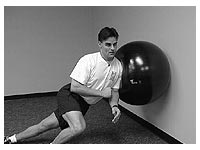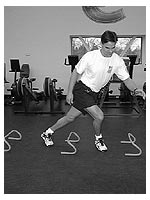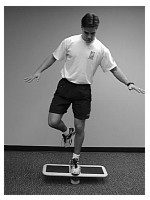






 |


Summer Choices
Hockey-Specific Cond...
Prevent Ankle & Knee
Yr-Round Train. Sched.
Post-Season - May 31st
Quickness & Agility
Balance Training
Improving Player Dev.
Flexibility for Skill
Overload Skating
Proven Training Tips
Anaerobic Running
Youth Strength Training
About Peter Twist

Camps
SportConditioning.ca
By Peter Twist MPE, BPE, CSCS © 2001 Peter Twist Peter Twist is President & CEO of Twist Conditioning Inc and the former Coach of Conditioning & Player Development for the Vancouver Canucks. He has authored dozens of articles on athlete development in scientific journals, written two books on conditioning and is currently finishing a third on core stability. Peter Twist runs weekly sport-specific conditioning camps for professional athletes, high school students, and adult recreational athletes, as well as one-on-one training and team clinics. He can be contacted through www.sportconditioning.ca or 604-904-6556. In sports requiring athletic movements and explosive actions under random and unpredictable conditions, injuries will always be a part of the game. However, by examining the characteristics of specific sports and understanding the amazing human machine, one can both enhance performance and prevent many injuries. The ankle and knee joints are especially susceptible to injury. Ligaments connect bone to bone, allowing some movement while restricting others. Tendons attach muscles to bones. Ligaments can be sprained (stretched too far, torn) when twisted beyond their range of motion, while tendons can be torn right off their bony attachment. More often, however, the tendon is damaged at the muscle-tendon junction, where muscle blends with tendon. While most knee and ankle injuries are described as "acute", blaming the sprain or tear on one obvious action, most injuries are a result of a longer process. In last months article, Balance Training, you discovered your body is a linked system that needs to be trained with more functional and real life exercises. Because your body is a linked system, any flexibility imbalances or minor problems in one area of the body effect other muscles and joints. For example, the body compensates for a tight left groin muscle by shifting more of the body weight to the right side of the body, as a protective mechanism. Over time, from repeated actions, working out and competing under this condition, this compensation shift leads to a damaged right knee or ankle. The final straw is one obvious sport action, but the body was set up over time to be injured. Most sport injuries can be traced back to other problems in other areas of the body. For this reason, a finely tuned body with equal strength and balanced flexibility between opposing muscle groups and between the left and right side of the body is key. In our example, the final blow that produces an injured knee or ankle is most often a quick stop upon decelerating or changing direction. Quick stops are paramount to sports requiring multi directional movements, cutting and reacting to opponent's tactics. Poor stopping technique, cutting while off balance, quick stops and lateral movement all factor in hockey knee injuries. Pre-habilitation exercises not only help prevent injuries, they improve performance and, if injured, lead to a more rapid return to competition. Ankle and knee tendon and ligament injuries can range from weeks to months for full recovery, so obviously it is easier and wiser to spend time on preventative methods. Prevention Variables Conditioning: A fatigued muscle is more easily injured, especially at the muscle-tendon junction during high-speed actions. A poorly conditioned athlete thinks less clearly, making poor decisions with poor technique. This all sets the body up for injury, especially when landing, cutting and stopping. Warm Up: If you have limited time pre-game, do not stretch. First, static stretching, positioned stationary like a statue, does not prepare the body to move explosively in a game. Second, stretching a cold muscle or rushing through a short stretching session actually sets muscles up to be injured. Use a dynamic movement-oriented warm up, with forwards, zig zag, lateral, backwards, figure 8's and other directions to activate every muscle in an easy, relaxed fashion. After you are warm and sweating, implement short jumps, bounds, and medicine ball passes to fire up the nervous system and ready the body for on-ice action. Flexibility: Gentle static stretching is valuable as a post-game, post-practice and post-workout routine. Hold stretches to 40 % range of motion for 60 seconds. You only want to feel a very mild stretch. Strong tension indicates muscle damage, not a good stretch. Most importantly, spend additional time stretching muscles that have a lower range of motion to re-balance all muscle groups. Strength: Good strength and musculature helps control movement, produce efficient technique and serves as your joint's natural brace.  Eccentric (muscle lengthening - the negative phase of a lift) strength is vital to prevent stopping and braking injuries. Strength training by sitting on a machine, lifting one body part through a restricted range of motion actually causes sport injuries. Break out of the dysfunctional fitness paradigm of the '90's. Meet with a coach or exercise specialist who coaches athletes versus fitness enthusiasts, and learn how to do multi joint lifts in a standing position. Multi joint lifts use the ankle, knee, hip and sometimes shoulder joints together to produce the desired movement - using your body as a linked system! While traditional multi joint lifts use an olympic bar, other strength maneuvers can also be classified as multi joint, such as the photo above, the stability ball angled single leg wall squats. Notice the dramatic angle replicating the joint forces and angles needed during cutting and sideways stops on the court. Eccentric (muscle lengthening - the negative phase of a lift) strength is vital to prevent stopping and braking injuries. Strength training by sitting on a machine, lifting one body part through a restricted range of motion actually causes sport injuries. Break out of the dysfunctional fitness paradigm of the '90's. Meet with a coach or exercise specialist who coaches athletes versus fitness enthusiasts, and learn how to do multi joint lifts in a standing position. Multi joint lifts use the ankle, knee, hip and sometimes shoulder joints together to produce the desired movement - using your body as a linked system! While traditional multi joint lifts use an olympic bar, other strength maneuvers can also be classified as multi joint, such as the photo above, the stability ball angled single leg wall squats. Notice the dramatic angle replicating the joint forces and angles needed during cutting and sideways stops on the court.
Quickness and Agility: An aerobic-based program (stairclimbers, continuous paced bike, jogging) trains the body to move slowly through a repetitive movement pattern and ultimately produces sport injuries.  Forget aerobics and instead use anaerobic intervals and agility drills. Agility and mobility drills elevate athleticism and prepare the body to safely handle unexpected movements. A word on plyometrics - the injury risk associated with plyometrics far exceeds potential benefit, especially with elementary and high school athletes and adult weekend warriors. Plyometrics are appropriate for well-trained, physically mature elite athletes. They are an injury waiting to happen for all others. There are many quickness and agility drills that improve sport performance without the risk. This photo shows a lateral micro hurdle drill. These hurdles are only 5 inches high, to minimize impact forces and emphasize quick feet. Forget aerobics and instead use anaerobic intervals and agility drills. Agility and mobility drills elevate athleticism and prepare the body to safely handle unexpected movements. A word on plyometrics - the injury risk associated with plyometrics far exceeds potential benefit, especially with elementary and high school athletes and adult weekend warriors. Plyometrics are appropriate for well-trained, physically mature elite athletes. They are an injury waiting to happen for all others. There are many quickness and agility drills that improve sport performance without the risk. This photo shows a lateral micro hurdle drill. These hurdles are only 5 inches high, to minimize impact forces and emphasize quick feet.
Proprioception and Balance: These exercises build strength around the joint and also help produce  more efficient sport technique, aiding performance and preventing many injuries. They can also be used as a warm up before games and practices. This photo shows a single leg 1/5 squat on a balance board. To make more challenging, close your eyes to remove visual feedback on your position in space. This is a terrific ankle and knee pre-habilitation exercise, engaging all of the sensors in the muscle and tendon and joint that send feedback to the brain and spine to contract muscles and stabilize the joint. Training on unstable surfaces helps build core strength, athleticism and strong joints! more efficient sport technique, aiding performance and preventing many injuries. They can also be used as a warm up before games and practices. This photo shows a single leg 1/5 squat on a balance board. To make more challenging, close your eyes to remove visual feedback on your position in space. This is a terrific ankle and knee pre-habilitation exercise, engaging all of the sensors in the muscle and tendon and joint that send feedback to the brain and spine to contract muscles and stabilize the joint. Training on unstable surfaces helps build core strength, athleticism and strong joints!
|
 project
project© 1999 DavidSport Inc. All Rights Reserved. Disclaimer